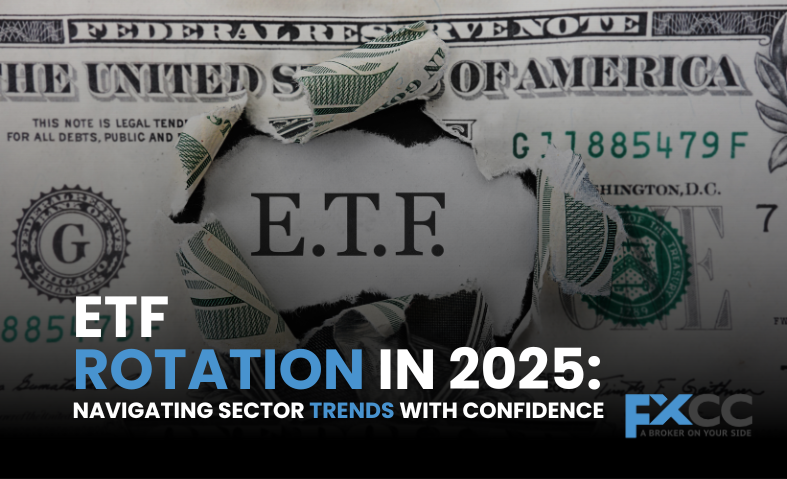What is ETF Rotation & Why Does it Matter in 2025?
ETF rotation is a proactive investment strategy that involves shifting your money between different sector-based Exchange-Traded Funds (ETFs) based on market trends and economic conditions. Instead of sticking to a static mix of investments, ETF rotation allows investors to follow the momentum—allocating capital to sectors that are rising and moving out of those that are falling behind.
In 2025, this approach has taken on renewed significance. With inflation cooling, interest rates staying higher for longer, and tech-driven disruption reshaping industries, investors are seeing sharper sector performance divergence. ETF rotation helps investors seize growth potential while reducing exposure to market downturns.

Top Trends Driving Sector Rotation in 2025
Understanding what’s driving sector performance is key to executing a smart rotation strategy. Several major forces are at play in 2025:
- Artificial Intelligence (AI) is fueling exponential growth in technology and industrial automation.
- Green energy policies are pushing clean energy and utilities to the forefront.
- Persistent high interest rates are favoring financial stocks and hurting rate-sensitive sectors like real estate.
- Consumer behavior shifts are boosting some discretionary sectors while hitting others hard.
These macroeconomic and technological trends create new winners and losers in the market almost every quarter. That’s where ETF rotation shines—helping you follow the leaders and leave the laggards behind.
Sectors Gaining Momentum in 2025
Let’s break down which sectors are capturing investor interest this year and the ETFs that represent them:
1. Technology and AI
Tech is leading again, but this time it’s more targeted. Artificial intelligence, robotics, and automation are leading the next wave of innovation. ETFs like BOTZ, ROBO, and ARKQ are outperforming broader tech ETFs because they focus specifically on future-ready companies.
2. Clean Energy
With the U.S. and Europe doubling down on green infrastructure, clean energy ETFs like ICLN, TAN, and QCLN are getting a strong boost. Renewable energy isn’t just about the environment—it’s now a growth market.
3. Financials
Banks and insurance companies are thriving in the current high-rate environment. ETFs such as XLF and VFH offer broad exposure to financial institutions that benefit from increased lending margins and stable balance sheets.
4. Healthcare and Biotech
The aging population and post-pandemic innovation are driving renewed interest in healthcare. ETFs like XLV, IBB, and XBI provide access to a diversified portfolio of top-performing medical and biotech firms.
How to Build an ETF Rotation Plan
If you want to use ETF rotation effectively in 2025, follow this straightforward plan:
1. Watch the Economy
Keep an eye on critical economic signals such as inflation trends, job market data, and interest rate movements. These metrics shape how different sectors perform.
2. Rank Sector ETFs
Use monthly or quarterly performance rankings. Tools like Morningstar, Finviz, or even Google Sheets can help you sort ETFs based on returns and momentum.
3. Rotate Quarterly
Every three months, move your investments into the top-performing 2-3 sector ETFs. Keep it data-driven, not emotional.
4. Limit Exposure to Underperformers
Avoid sectors that consistently lag behind or react poorly to the current economic cycle. Reallocate funds from weak sectors into stronger ones to keep your portfolio fresh.
Tools to Help You Rotate with Confidence
There are several platforms and resources you can use to make ETF rotation simple and effective:
- Stock Charts – Great for technical analysis and sector rotation charts.
- ETF.com – Offers deep insights into each ETF’s holdings and sector exposure.
- M1 Finance – Lets you build and automate sector-based portfolios.
- Yahoo Finance & Seeking Alpha – Good for tracking ETF news and analyst insights.
With these tools, even casual investors can build a data-backed, trend-following ETF rotation strategy without needing to be full-time traders.

Stay Flexible, Stay Profitable
In a market as fast-moving and unpredictable as 2025, flexibility is key. ETF rotation isn’t about timing the market perfectly—it’s about being alert, responsive, and disciplined. By focusing on sector performance and economic signals, you can avoid stagnation and give your portfolio the agility it needs to thrive. Stay informed, rotate with purpose, and you’ll have a solid edge in this year’s ever-shifting investment landscape.


